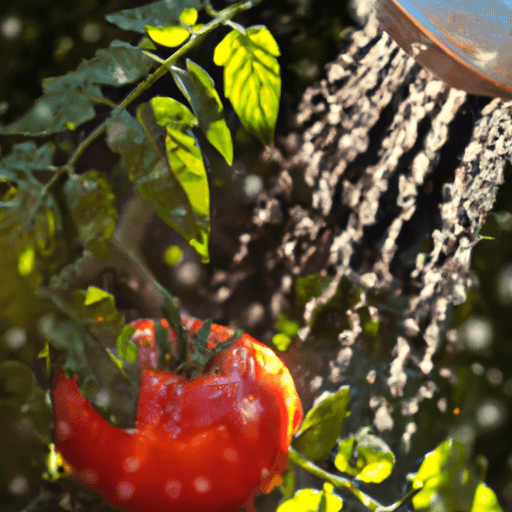Proper watering is crucial for the health and growth of tomato plants. Signs like wilting, yellowing leaves, and slowed growth indicate the need for water. To ensure healthy tomato plants, it is important to follow some key tips.
These include checking soil moisture before watering, watering at soil level to prevent wetting the leaves and stems, and watering deeply and slowly for better absorption. The frequency of watering depends on factors like growth stage and soil type.
Specific guidelines for watering potted tomatoes and tomatoes in raised beds are also provided. With these watering tips, you can promote the health and growth of your tomato plants effectively.
Signs Your Tomato Plants Need Water
If tomato plants are wilting, have wilted or drooping leaves and stems, or exhibit inward curling of leaves, these are signs that they need water. Monitoring the soil is crucial in preventing overwatering. One should check the top 2 to 3 inches of soil for any signs of dryness, such as dustiness or cracking.
In addition to visual cues, slowed or halted growth and yellowing of the bottom leaves can also indicate a lack of water. To prevent overwatering, it is important to check the soil moisture before watering. Watering at soil level instead of wetting the leaves and stems is recommended. Deep and slow watering allows for better absorption.
It is best to water tomato plants in the morning, and if needed, water again in the late afternoon.
Tips for Properly Watering Tomato Plants
To ensure proper hydration, gardeners should aim to water tomato plants deeply and slowly for better absorption. Proper watering techniques are essential for maintaining optimal soil moisture, which is crucial for the health and productivity of tomato plants.
When watering tomato plants, it is important to water at soil level to prevent wetting the leaves and stems. This not only prevents diseases but also ensures that the water reaches the roots where it is needed the most.
Watering should be done in the morning to allow the plants to absorb the moisture throughout the day. If needed, watering can be done again in the late afternoon.
Frequency of Watering for Tomato Plants
Daily watering is necessary for new tomato transplants to establish strong roots. To ensure healthy tomato plants, it’s important to follow a proper watering schedule and use effective watering methods.
Here are three key points to consider:
-
Watering schedule: Daily watering is essential for newly transplanted tomato plants. As the roots are still developing, consistent moisture is crucial for their establishment. Adjust the watering frequency and amount as the tomatoes start to ripen.
-
Watering methods: Water at soil level to prevent wetting the leaves and stems, which can lead to disease. It’s recommended to water deeply and slowly to promote better absorption. Additionally, watering in the morning allows the plants to dry before nightfall, reducing the risk of fungal infections.
Watering Tips for Potted Tomato Plants
Watering tomato plants in pots requires keeping the soil moist without making it soggy. The pot size and watering frequency play important roles in maintaining the health of potted tomato plants.
The size of the pot affects the saturation levels of the soil. Larger pots with a minimum depth of 8 inches provide ample space for the roots to grow and retain moisture better than smaller pots.
The watering frequency for potted tomatoes may need to be adjusted depending on the weather conditions. In hot and dry conditions, mature tomato plants may require up to a gallon of water per day.
It is essential to monitor the soil moisture and water daily at soil level, ensuring that the soil is moist but not overly saturated.
Watering Techniques for Tomato Plants in Raised Beds
Raised beds provide an ideal growing environment for tomatoes, allowing for efficient water delivery to the roots through the use of soaker hoses. To ensure healthy tomato plants in raised beds, it is important to have a proper watering schedule and use effective irrigation methods. Here are three key techniques to consider:
-
Watering frequency: Tomatoes in raised beds generally require watering three to four times per week. This allows the water to deeply penetrate the soil and reach the roots, promoting strong and healthy growth.
-
Shallow bed monitoring: Since raised beds have limited soil depth, it is crucial to check them daily for signs of dehydration. If the topsoil appears dry, it may be necessary to water more frequently for shorter periods of time.
-
Soaker hose irrigation: Installing soaker hoses in raised beds ensures efficient water delivery directly to the roots. These hoses can be set on timers, making it easy to maintain a consistent watering schedule and prevent over or under-watering.
Best Practices for Watering Healthy Tomato Plants
To ensure optimal growth and fruit production, tomato plants benefit from consistent moisture levels in the soil. A proper watering schedule is crucial for maintaining the health of tomato plants.
Watering tools such as soaker hoses and timers can help ensure efficient and effective watering. It is important to water tomato plants deeply and slowly, allowing for better absorption. Watering should be done at soil level to prevent wetting the leaves and stems, which can lead to disease.
It is recommended to water tomato plants in the morning, and if necessary, again in the late afternoon. New tomato transplants require daily watering to establish strong roots, while mature plants may need up to a gallon of water per day in hot and dry conditions.







